Related Research Articles
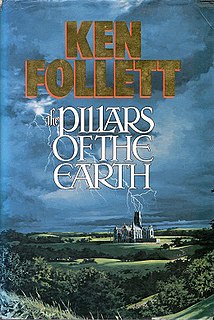
The Pillars of the Earth is a historical novel by Welsh author Ken Follett published in 1989 about the building of a cathedral in the fictional town of Kingsbridge, England. Set in the 12th century, the novel covers the time between the sinking of the White Ship and the murder of Thomas Becket, but focuses primarily on the Anarchy. The book traces the development of Gothic architecture out of the preceding Romanesque architecture, and the fortunes of the Kingsbridge priory and village against the backdrop of historical events of the time.

The Global Biodiversity Information Facility (GBIF) is an international organisation that focuses on making scientific data on biodiversity available via the Internet using web services. The data are provided by many institutions from around the world; GBIF's information architecture makes these data accessible and searchable through a single portal. Data available through the GBIF portal are primarily distribution data on plants, animals, fungi, and microbes for the world, and scientific names data.
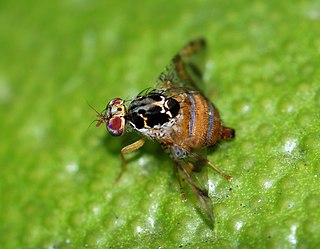
Ceratitis capitata, commonly known as the Mediterranean fruit fly or medfly, is a yellow and brown fruit pest that originates from sub-Saharan Africa. C. capitata has no near relatives in the Western Hemisphere and is considered to be one of the most destructive fruit pests in the world. There have been occasional medfly infestations in the states of California, Florida, and Texas that required extensive eradication efforts to prevent the fly from establishing itself in the US.
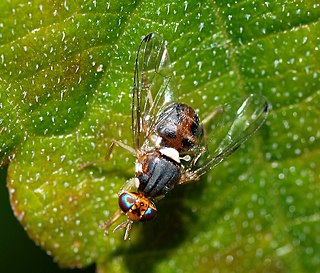
The Dacinae are a subfamily of the fruit fly family Tephritidae. Its 41 genera are distributed among three tribes:
The Catalogue of Life is an online database that provides the most comprehensive and authoritative index of known species of animals, plants, fungi, and microorganisms. It was created in 2001 as a partnership between the global Species 2000 and the American Integrated Taxonomic Information System. The Catalogue interface is available in twelve languages and is used by research scientists, citizen scientists, educators, and policy makers. The Catalogue is also used by the Biodiversity Heritage Library, the Barcode of Life Data System, Encyclopedia of Life, and the Global Biodiversity Information Facility. The Catalogue currently compiles data from 168 peer-reviewed taxonomic databases, that are maintained by specialist institutions around the world. As of June 2021, the Catalogue lists 1,997,284 of the world's 2.2m extant species known to taxonomists on the planet at present time.
Plazi is a Swiss-based international non-profit association supporting and promoting the development of persistent and openly accessible digital bio-taxonomic literature. Plazi is cofounder of the Biodiversity Literature Repository and is maintaining this digital taxonomic literature repository at Zenodo to provide access to FAIR data converted from taxonomic publications using the TreatmentBank service, enhances submitted taxonomic treatments by creating a version in the XML format Taxpub, and educates about the importance of maintaining open access to scientific discourse and data. It is a contributor to the evolving e-taxonomy in the field of Biodiversity Informatics.

Van Sung's shrew, also known as Cao Van Sung mountain shrew is a species of shrew in the Soricomorpha order. Specimens of Chodsigoa caovansunga have been found in Vietnam.

The Pillars of the Earth is an eight-part 2010 TV miniseries, adapted from Ken Follett's 1989 novel of the same name. It debuted in the U.S. on Starz and in Canada on The Movie Network/Movie Central on July 23, 2010. Its UK premiere was on Channel 4 in October 2010 at 9pm. In 2011, the series was nominated for 3 Golden Globes, including Best Mini-Series or Motion Picture Made for Television, Ian McShane for Best Actor and Hayley Atwell for Best Actress at the 68th Annual Golden Globe Awards.
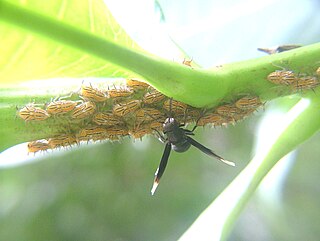
Parachartergus apicalis is a species of wasp in the Polistinae subfamily, found in the Neotropics. It was first described by Johan Christian Fabricius in 1804. In Honduras, they are known as alas blancas, which translates into English as "white wings".
Ceratitis ovalis is a species of Tephritid or fruit flies in the family Tephritidae.
Ceratitis grahami is a species of insect in the family Tephritidae. This is a genus of Tephritid or fruit flies.
Ceratitis flexuosa is a species from the kingdom Animalia, family Tephritidae. This is a genus of Tephritid or fruit flies.
Ceratitis penicillata is a species of fruit fly from the family Tephritidae.
Ceratitis podocarpi is a species of fruit flies in the family Tephritidae. It is a pest of various cultivated species of Cucurbitaceae, especially the pumpkin, squash and melon. Ceratitis podocarpi is found in almost all Southern African countries like Ethiopia, Kenya, South Africa.
Ceratitis andranotobaka is a species of tephritid fruit fly.
Rhadalognathus was a prehistoric crocodile-like amphibian that belongs to the Mastodonsauridae family. Not much is known about this creature but it lived in the Triassic period. Rhadalognathus is also the name of the genus in which the organism belongs within. Rhadalognathus was found in northern Arizona, US, by S. P. Welles in 1947. The size of the organism is unknown but its skull is about 17in long and weighs 7lbs.
Plectris aliena is a species of scarab beetle in the family Scarabaeidae. It is found in Australia, North America, and South America.

The Interim Register of Marine and Nonmarine Genera (IRMNG) is a taxonomic database which attempts to cover published genus names for all domains of life from 1758 in zoology up to the present, arranged in a single, internally consistent taxonomic hierarchy, for the benefit of Biodiversity Informatics initiatives plus general users of biodiversity (taxonomic) information. In addition to containing over 490,000 published genus name instances as at March 2020, the database holds over 1.7 million species names, although this component of the data is not maintained in as current or complete state as the genus-level holdings. IRMNG can be queried online for access to the latest version of the dataset and is also made available as periodic snapshots or data dumps for import/upload into other systems as desired.

Ernest James Harris was an American entomologist who is best known for his work on Biosteres arisanus, a species of wasp. He was inducted into the Arkansas Black Hall of Fame in 1999.
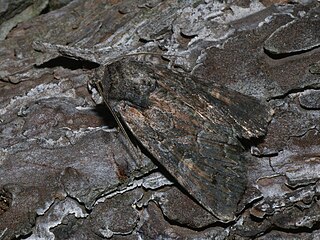
Lacanobia aliena is a species of butterfly belonging to the family Noctuidae.
References
- ↑ "Ceratitis aliena - Overview - Encyclopedia of Life". Encyclopedia of Life. Retrieved 2016-01-27.
- ↑ GBIF. "Ceratitis aliena (Bezzi, 1920) - Checklist View". www.gbif.org. Retrieved 2016-01-27.